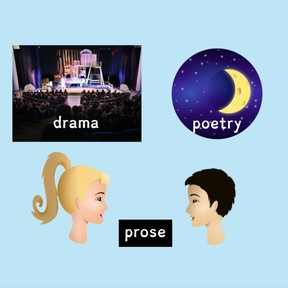
Poetry, drama, and prose
I can describe the major differences between poetry, prose and drama.



8,000 schools use Gynzy
92,000 teachers use Gynzy
1,600,000 students use Gynzy
General
In this lesson, students will learn the characteristics of poetry, prose, and drama to distinguish between and even write them. They will read through examples of each.
Standards
CCSS.ELA-Literacy.RL.4.5
Learning objective
Students will be able to describe the major differences between poetry, prose, and drama.
Introduction
Students will discuss as a class what they know about prose, poetry, and drama and fill out a chart with their ideas.
Instruction
They will be introduced to prose: text written in the way we speak. They will read an example of prose from Westlandia by Paul Fleischman. They will then underline the sentences that are spoken by the character. After that activity, they will discuss what they know about prose at this point.
Students will read a poem called, "Poor Old Lady," and be shown the structure, including stanzas, stanza breaks, and meter. They'll also look at different types of poetry, like sonnets, free verse, limericks, and haiku. They will remember the words to "Twinkle, Twinkle Little Star."
They will then be introduced to dramas. They will read a script from "The Animal Trailer" from Readers Theater and answer questions about the speaking parts and stage directions.
Quiz
Students will answer 10 questions distinguishing between prose, poetry, and drama, and their characteristics.
Closing
Have students recall what they learned about prose, poetry, and drama. Students will create their own civilization or town and choose a writing idea.
The online teaching platform for interactive whiteboards and displays in schools
Save time building lessons
Manage the classroom more efficiently
Increase student engagement
Discover more!
About Gynzy
Gynzy is an online teaching platform for interactive whiteboards and displays in schools.
With a focus on elementary education, Gynzy’s Whiteboard, digital tools, and activities make it easy for teachers to save time building lessons, increase student engagement, and make classroom management more efficient.



